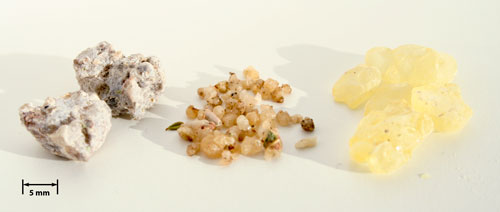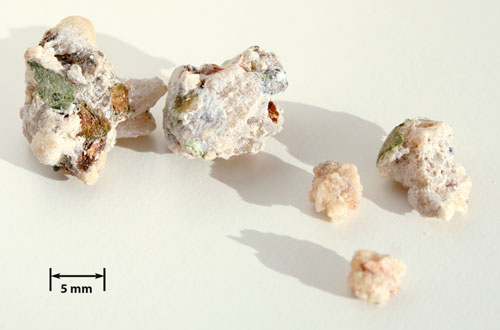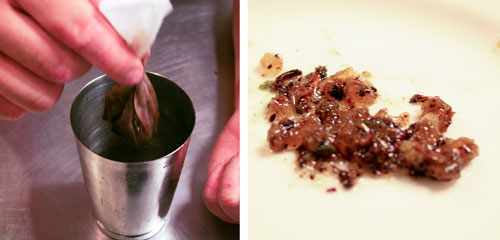by Dave Arnold
Today I had my first article published in the New York Times, and it’s on  manna. Yes, like manna from heaven. Here is the link. Below is a short  post with some additional information. The first part is (mostly) a quote from the article. For the full skinny go to the NY times website. The second part of the post has some info I couldn’t fit into the article.

From the article (mostly):
After a couple months of wandering around the Sinai after their exodus from Egypt, the Israelites got hungry and started grumbling. God conjured up two things for them –quails in the evening, and manna in the morning.  “In the morning there was a layer of dew around the camp. When the layer of dew evaporated, behold, on the surface of the wilderness there was a fine flake like thing, fine as frost on the ground. When the sons of Israel saw it, they said to one another, “What is it?†(Exodus 16:13-15)†“What is it,†in ancient Hebrew, is mân-hû –the probable derivation for the word manna. As for its description: “It was like coriander seed, white, and its taste was like wafers with honey (Exodus 16:31).â€
Turns out, manna is real. There are dozens of varieties, and they have been used for millennia. The defining features of all mannas are 1) they are sweet, and 2) they appear as if from nowhere, delivered by Providence, without cultivation. Most manna is either dried plant sap or the honeydew excreted by bugs that eat the sap. Rarer are the non-sap mannas, including Trehala manna, the sweet-tasting cocoon of the Larinus maculates beetle, and manna-lichen (Lecanora esculenta), which dries up and blows around to form semi-sweet clouds out of which manna settles into drifts – a literal windfall. Biblical manna was almost certainly a sap manna –the favored theory says the Israelites’ came from a tamarisk tree (Tamarix gallica). Every continent has sap mannas. They form best in extremely dry climates –like the middle east’s  – where sap oozes during the night and dries up in the morning.
Additional info (mostly):
Some people believe that manna can simply drip spontaneously from a tree or bush. Unlikely – most tree species, even those with an extremely wide geographical range, only produce manna in very specific regions and at very specific times. This production pattern points to the intervention of bugs. Ravenous insects puncture holes in the stems, leaves and roots of the plant, causing sap to run. Sometimes the bugs eat the sap and poop it out as sweet honeydew. Like the familiar aphids that produce honeydew here, manna-producing bugs, like the Coccus manniparu responsible for Tamarisk manna, are very small and can go unnoticed even by the gatherers and casual studiers of manna.  People aren’t the only manna enjoyers: ants and other insects collect it, too. Exodus warns us that if we leave our manna sitting around it will attract maggots.
I have not been able to locate the biblical Tamarisk manna here in the United States.
There are two types of manna available here in the US from Behroush Sharifi the Saffron King, dealer in rare spices and dried foods from ancient Silk Road: Hedysarum and Shir-Khesht. Both are products of Iran and are imported from the bazaar in the town of Yazd. They are some of the most unprocessed foods you can get. They contain bits of leaves and twigs and who knows what else.
Hedysarum is the dried sap of the camelthorn bush. It looks like this:

It tastes like a combination of maple syrup, brown sugar, blackstrap molasses, honey, and nuts - delicious. My wife detected a note of clams –not like eating clams, but like the aftertaste. Upon re-tasting the manna, I detected that flavor as well; it wouldn’t stop me from using it in a dessert. Her response to the Hedysarum  supports Mr. Sharifi’s claim that manna tastes different to different people and has a wide range of nuanced flavors. According to the most recent work I have found – which dates from the 1880’s — Hedysarum contains melezitose. Melezitose is a trisaccharide sugar associated with honeydew in aphids, which points to Hedysarum’s  bug-derivation.
Shir-Khesht manna is the dried sap of the cotoneaster nummilaria shrub. It looks like this:

Shir-khesht (which means “dried-milk†in Persian) is whiter than hedysarum manna. It is sweet, with some gumminess that eventually dissolves in the mouth. Shir-khesht has a tongue-cooling effect that comes from mannitol, a sugar alcohol in this and many other mannas; the sensation is similar to menthol, without the menthol taste. Mannitol is tolerated by diabetics and is reputed to have other medical benefits. It also has notes of honey and herb, and a faint bit of citrus peel.
Wylie Dufresne (my brother in law) sprinkles Shir-Khesht on foie gras. At the FCI we make a drink with it. Traditionally, manna was boiled into syrups to purify it for medicinal preparations. We heat two parts water to one part Shir-Khesht manna, strain it, and add the syrup to bourbon. Consume this drink neat, at room temperature. As with the raw manna, the drink changes as you sip it. It is sweet, but not overly so. It is cooling, complex and satisfying.


Oh. Don’t eat too much manna at once. Its indigestible sugars make it act as a laxative. The $28 an ounce price tag will help you avoid this problem.
For a gentle non-habit forming sleep inducer, check out Manna: An Historical Geography, By R.A. Donkin, published by Junk (no joke), 1980.

Absolutely fascinating. I had no idea manna actually existed. Thanks for another banging write-up.
manna from the gods!
congrats on the article!
I’m confident we can recreate this material. We have already made some progress with a mixture of gum Arabic, mannitol and clam juice that we put through the VitaPrep and then in the lyophilizer overnight. I just need to find some lawn mower trimmings to garnish, but I am having trouble finding that ingredient in lower Manhattan.
Thanks Dave for an excellent article. I read it in nytimes but I did not notice it was by you. We often do not realize the importance of what we do, this article by you is an example. I frequently visit an elderly Persian gentleman who is nearing the end of his life. He is from Yazd and will be thrilled to read this article.
Thanks for the note Phoxx.
This is timely and interesting, since a couple of days before this post a friend of mine brought me a box of Tofiq Halwachy from Iraq. It’s a manna-based sweet, bound with glucose and egg albumen. Don’t know if you’ve tried it – it’s got a sort of nougaty quality. Let me know if you want me to send some up to you – we’re unlikely to eat it all, at least in this form.
Wow, very interesting. Heard a lot about Manna since I was a child and happy to know that you can even make a drink with it! Go for the second article…